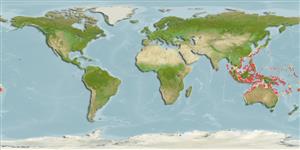Actinopterygii (ray-finned fishes) >
Perciformes (Perch-likes) >
Gobiidae (Gobies) > Gobiinae
Etymology: Fusigobius: Latin, fusus = spindle + Latin, gobius = gudgeon (Ref. 45335); melacron: Named for the dark upper part of the dorsal fin.
Environment / Climate / Range
Ecology
Marine; demersal; depth range 7 - 31 m (Ref. 90102). Tropical, preferred ?
Indo-West Pacific.
Size / Weight / Age
Maturity: Lm ? range ? - ? cm
Max length : 3.5 cm SL male/unsexed; (Ref. 41649); 3.6 cm SL (female)
Dorsal
spines
(total): 6 - 7;
Dorsal
soft rays
(total): 10;
Anal
spines: 1;
Anal
soft rays: 9. Characterized by semi-translucent grey with numerous small yellowish brown or dusky orange-red spots; presence of series of larger dark blotches along back; brown to blackish outer half of first dorsal fin; pelvic fins united only at base; absence of pelvic frenum; rounded caudal fin; longitudinal scale series 27; ctenoid scales except cycloid on breast, base of pectoral fin and few scales on side of nape; operculum without scales; median predorsal scales absent; opening of gill extending to below rear edge of preopercle; depth of body 4.7-5.2 in SL (Ref. 90102).
Inhabits sand-rubble bottoms next to reefs in 7-31 m (Ref. 90102).
Life cycle and mating behavior
Maturity | Reproduction | Spawning | Eggs | Fecundity | Larvae
Randall, J.E., 2001. Five new Indo-Pacific gobiid fishes of the genus Coryphopterus. Zool. Stud. 40(3):206-225. (Ref. 41649)
IUCN Red List Status (Ref. 115185)
CITES (Ref. 94142)
Not Evaluated
Threat to humans
Harmless
Human uses
More information
Common namesSynonymsMetabolismPredatorsEcotoxicologyReproductionMaturitySpawningFecundityEggsEgg development
ReferencesAquacultureAquaculture profileStrainsGeneticsAllele frequenciesHeritabilityDiseasesProcessingMass conversion
Tools
Special reports
Download XML
Internet sources
Estimates of some properties based on models
Phylogenetic diversity index (Ref.
82805): PD
50 = 0.5005 [Uniqueness, from 0.5 = low to 2.0 = high].
Bayesian length-weight: a=0.00631 (0.00286 - 0.01390), b=3.08 (2.90 - 3.26), in cm Total Length, based on LWR estimates for this (Sub)family-body shape (Ref.
93245).
Trophic Level (Ref.
69278): 3.2 ±0.3 se; Based on size and trophs of closest relatives
Resilience (Ref.
69278): High, minimum population doubling time less than 15 months (Preliminary K or Fecundity.).
Vulnerability (Ref.
59153): Low vulnerability (10 of 100) .
